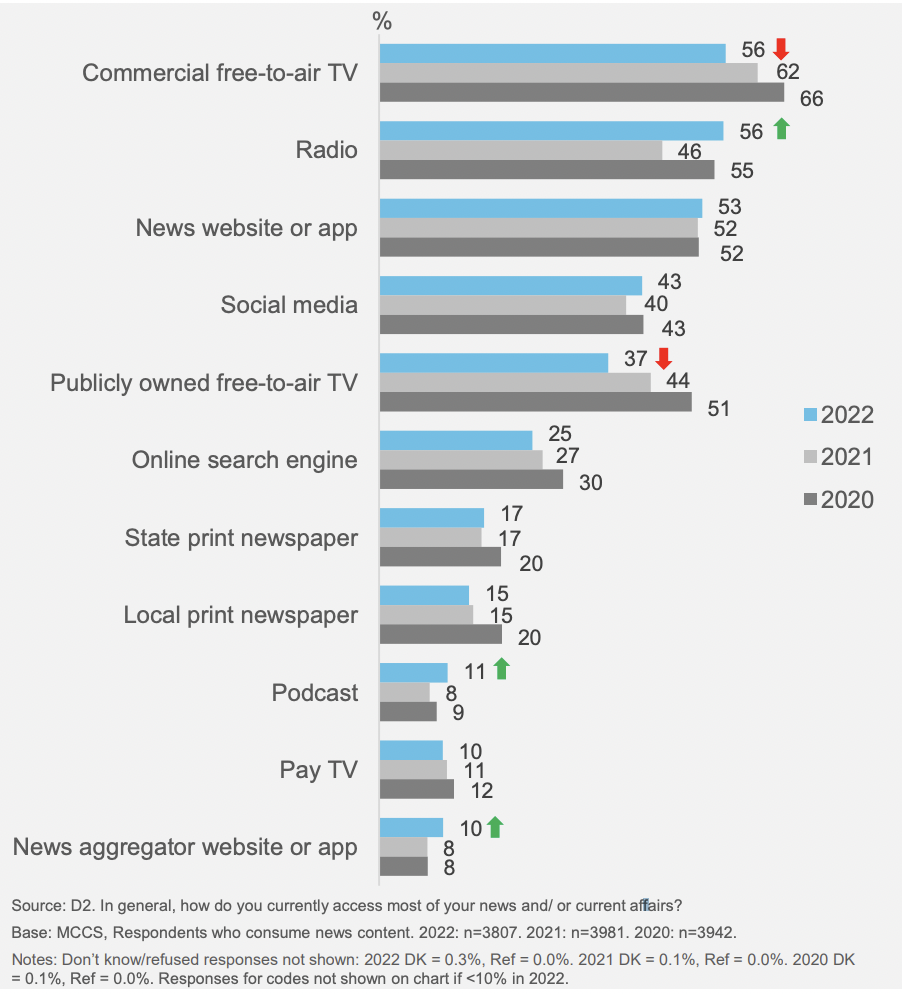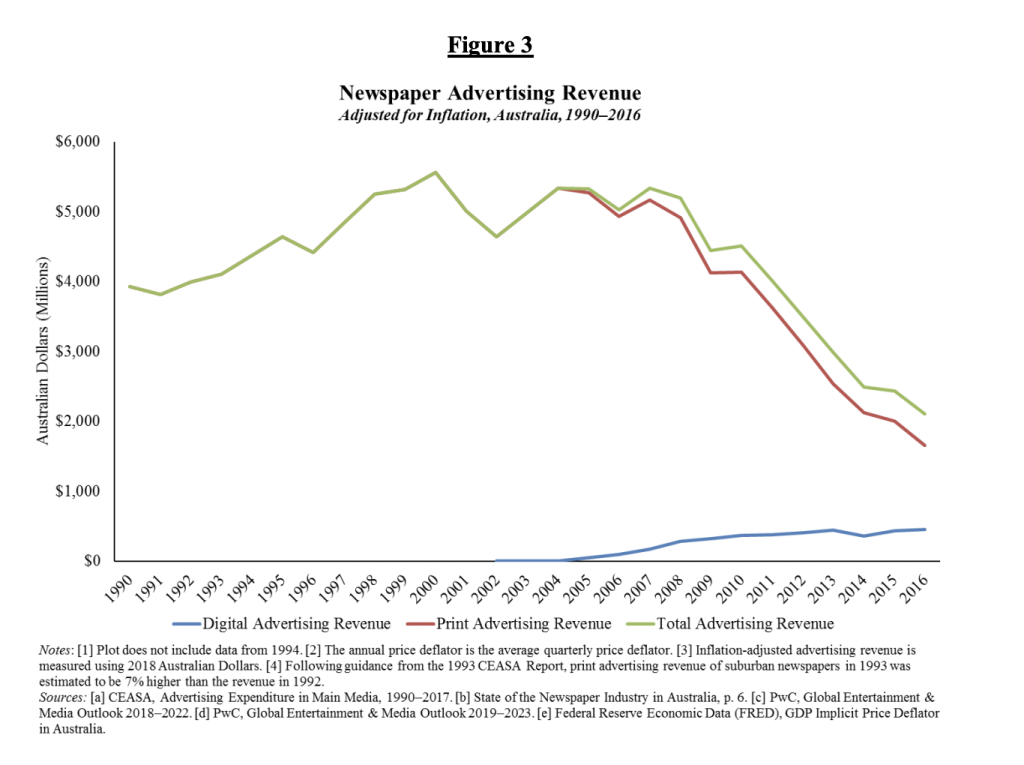1.0 Introduction
In recent years, traditional media in Australia has been challenged by a new source of content: social media platforms have risen to new levels of popularity. Silicon Valley’s digital platforms, such as Meta, X, and TikTok allow people to access content worldwide, eroding traditional media structures and creating an infrastructure for a cross-national public dialogue (Gillespie, 2018, 5-8). These tech giants and new technology create challenges for national and local news; UNESCO named social media an “existential threat to traditional, trustworthy news” (United Nations, 2022). What challenges do the platforms pose for the fourth estate in Australia? In this essay, I will focus on the Australian media landscape, first presenting the rise of platforms and the importance of freedom of expression through central theory, before discussing the effects of platform dominance on the Australian public dialogue, centered around the following thesis statement:
The rapid use of digital platforms to access news is reshaping the Australian media landscape, posingchallenges to the industry, including concerns about the erosion of the quality of journalism.
2.0 The Democratic Estates of Information Freedom
Traditional media has long stood as an important mediator in democracies, offering a fourth estate of information freedom, alongside the executive, judiciary, and legislative estates (Dutton, 2009, p. 1-3). Expression of freedom, rational debate, and participatory civil society, is vital to securing pluralism, balance of power, and justice, often secured by media watchdog (Schlesinger, 2020, 1549-1552). Several argue that a new estate has been created: the internet. This fifth estate is a core player in nations all over the world, creating a mediator between the people, governments, businesses, and the press (Dutton, 2009, p. 8-11) Platforms are “sites and services that host, organize, and circulate users’ shared content or social exchanges, mostly without having produced or commissioned that content”. In that way, platforms are an infrastructure for transnational, revenue-based communication, and stand as a rivaling force to local and national news media (Gillespie, 2018, p.19).
3.0 Rise in Use of Platforms as a News Source
In recent years, traditional media has lost attention, in line with the rise of hegemonic platforms, such as X, Meta, and YouTube. The 2022 Media Content Consumption Survey shows that 37% of Australians (n=4002) follow national news and 31% follow international news five times a week, primarily through commercial free-to-air TV (56%), radio (56%), news websites or apps (53%) and social media (43%) (DITRDCA, 2023). The two latter have increased, while commercial free-to-air TV and publicly owned TV have declined by 10% in the last year. Social Media have risen to be a popular source of news content, with 79% of respondents noting it as somewhat or very important. Facebook was noted to be the most popular, with 65% using it to access information, followed by Instagram, TikTok, and X, all three have increased in the last years (DITRDCA, 2023).
Figure 1: Sources of News in Australia (DITRDCA, 2023, p.39).

4.0 The Challenges to the Fourth Estate
In many ways, social media is an expansion of the public sphere, functioning as a mediator between governments, people, businesses, and the press (Schlesinger, 2020, p. 18-20). The use of social media can potentially be a democratizing force, expanding the freedom of expression and lowering the threshold for participating in public dialogue (Flew, Martin, and Suzor, 2019, p. 36). However, several argue that the growth of the fifth estate is harming the Australian media landscape.
4.1 Fake News, AI, and Biases: Eroding Truth-Based Journalism
Further on, the rise of Web 2.0 can harm truth-based information, with the rise of fake news and disinformation (Napoli, 2019, 60-65). The spread of false news to attract readers to de-legitimize opposition and manipulate public opinion. During COVID-19, platforms were a hotspot for disinformation, spreading miracle cures and hoaxes about the virus. A video published by ABC News Australia (2021) discussed how Sky News Australia was banned from publishing content on YouTube for a week after spreading false information about the virus.
The rise of AI opens for writing automatic articles, hindering accountability and censorship (Picard and Pickard, 2017). The Guardian noted that News Corp Australia produces 3000 articles weekly with AI tools (Meade, 2023). The use of AI in producing images, videos, sounds, and text that distort reality. One could argue that the nature of platforms, conflicts with ethical journalism, lowering the incentives for truth-based journalism and fostering a nature that promotes disinformation, clickbait-sensations, and fake news to attract readers (Schlesinger, 2020, p. 19-22).
Social media platforms ‘ algorithms create user-generated results that align with their existing beliefs, which can create a one-sided perspective, discriminating information, and hindering a nuanced view, known as echo chambers and filter bubbles (Schlesinger, 2020, p. 20-22). These biases in search engines can lead to a lack of diversity in the public dialogue. Owen (2017, p.828-830) argues that the rise of the fifth estate leads to a fragmented media ecosystem, where users are only exposed to existing opinions. lead to radicalization and polarization.
4.2 Loss of Revenue and Feud for Compensation
With the gradual shift from print to broadcasting on platforms and apps, traditional news has faced a loss in revenue and reduced compensation for journalistic work through advertisements on digital platforms (Bossio et al., 2022, p. 137-139). A study issued by the Australian Competition and Consumer Commission (ACCC) showed that Australian Newspapers lost 75% of total advertising revenue since 2005 (Shapiro, Hayes, and Makhija, 2020, p. 4).
Figure 2: News Advertising Revenue in Australia 1990-2016 (Shapiro, Hayes, and Makhija, 2020, p. 4)

To address the lack of compensation, the Australian government instituted the Mandatory News Media and Digital Platforms Bargaining Code in 2020 (Bossio et al., 2022, p. 136-141). The Australian News Media Bargaining Code (NMBC) is legislation drafted to make platforms operating in Australia pay the Australian news for content, allowing collective bargaining for companies with profits under ten million dollars, and securing platforms to inform news about changes in algorithms for their content 28 days before enacted (Heylen, 2023, p.13). The code was passed in parliament, and inaugurated in March 2021, to “address a bargaining power imbalance that exists between digital platforms and Australian news businesses” to “help to sustain public interest journalism in Australia” (ACCC, 2022). The code was met with varied feedback; Facebook removed Australian news in February 2021 and Google threatened to pull out of the market. In a video published by BBC News (2021), the Australian prime minister says: “We don’t respond to threats”.
The Australian government responded with a critique of the “immense market power of these digital social giants” and said they would stop their advertising on Metas platforms (Clayton, 2021). This was followed by Facebook restoring the content and Google and Facebook making agreements with Australian news in line with the NMBC. The NMBC and the aftermath show the hostile nature of the relationship between the media and tech giants when building a bargaining framework (Bossio et al., 2022, p. 144-148). The regulation is an example function to fix the imbalance between the estates to hinder disinformation and echo chambers, deflate hegemonic tech giants, and promote democratic procedure, fair pay for news publishers, revaluation of power, and a lively civil society in the digital ecosystem (Heylen, 2023, p. 5-11).
5.0 Conclusion
Media is a vital estate that secures justice, balance of power, and truth in society. In recent years, the use of digital platforms to access news has risen among citizens, while traditional media, such as the use of TV is declining (Dutton, 2009, 2-3; DITRDCA, 2023). These trends pose challenges in the media industry. On one side, the new technology can function as an emancipating force, lowering the threshold to contribute, connect, and gather information in the public sphere (Gillespie, 2018, p. 11-13). However, the platform dominance creates challenges for people, governments, businesses, and news media, and poses threats to the fourth estate. New trends of sensation-based content lower the threshold for low-quality journalism, opening for disinformation, fake news, clickbait content, lack of censorship, fueling echo chambers, and filter bubbles. Additionally, the change to platforms has vastly lowered news media’s advertisement-based revenue (Bossio et al. 2022, p. 141-144). The Australian government’s NMBC regulation can be seen as an attempt to meet the challenges facing traditional media.
6.0 References
ACCC. (2022, May 2). News media bargaining code. Australian Competition and Consumer Commission. https://www.accc.gov.au/by-industry/digital-platforms-and- services/news-media-bargaining-code/news-media-bargaining-code
ABC News (Australia). (2021, August 3). Sky News Australia banned from posting onYouTube for a week over COVID misinformation | 7.30. [Video]. YouTube. https://www.youtube.com/watch?v=gKxBvmiso6w
Shapiro, Hayes, and Makhija (2020). The Financial Woes of News Publishers in Australia. Australian Competition and Consumer Commission
BBC News. (2021, January 21). Google threat to pull search engine in Australia – BBC News [Video]. YouTube. https://www.youtube.com/watch?v=Vq9Yib3Dqs8&t=68s
Bossio, D., Flew, T., Meese, J., Leaver, T., and Barnet, B. (2022). Australia’s News Media Bargaining Code and the global turn towards platform regulation. Policy & Internet, 14(1), 136–150. https://doi.org/10.1002/poi3.284
Clayton, J. (2021, February 23). Facebook reverses ban on news pages in Australia. BBC News. https://www.bbc.com/news/world-australia-56165015
Department of Infrastructure, Transport, Regional Development, Communications and the Arts (DITRDCA) (2023). The 2022 Media Content Consumption Survey – Summary Report. The Social Research Centre. https://www.infrastructure.gov.au/sites/default/files/documents/Media%20Content%20Consumption%20Survey%202022%20-%20Final%20Report.pdf
Dutton, W. H. (2009). The Fifth Estate Emerging through the Network of Networks. Prometheus (Saint Lucia, Brisbane, Qld), 27(1), 1-15. doi:10.1080/08109020802657453
Flew, T., Martin, F., and Suzor, N. (2019). Internet regulation as media policy: Rethinking the question of digital communication platform governance. Journal of Digital Media & Policy, 10(1), 33-50. doi:10.1386/jdmp.10.1.33_1
Gillespie, T. (2018). Custodians of the Internet: Platforms, Content Moderation, and the Hidden Decisions That Shape Social Media. Yale University Press.
Heylen, K. (2023). Enforcing platform sovereignty: A case study of platform responses to Australia’s News Media Bargaining Code. New Media & Society, 0(0). https://doi.org/10.1177/14614448231166057
Meade, A. (2023, July 31). News Corp using AI to produce 3,000 Australian local news stories a week. The Guardian. https://www.theguardian.com/media/2023/aug/01/news-corp-ai-chat-gpt-stories
Napoli, P. M. (2018). What if more speech is no longer the solution? First Amendment theory meets fake news and the filter bubble. Federal Communications Law Journal, 70(1). 55-104.
Picard, R. G., and Pickard, V. (2017). Essential principles for contemporary media and communications policymaking. Reuters Institute for the Study of Journalism. https://reutersinstitute.politics.ox.ac.uk/sites/default/files/research/files/Essential%2520Principles%2520for%2520Contemporary%2520Media%2520and%2520Communications%2520Policymaking.pdf
Schlesinger, P. (2020). After the post-public sphere. Media, Culture & Society, 42(7-8), 1545- 1563. doi:10.1177/0163443720948003
United Nations. UN News (2022, March 10). Social media poses “existential threat” to traditional, trustworthy news: UNESCO. https://news.un.org/en/story/2022/03/1113702



